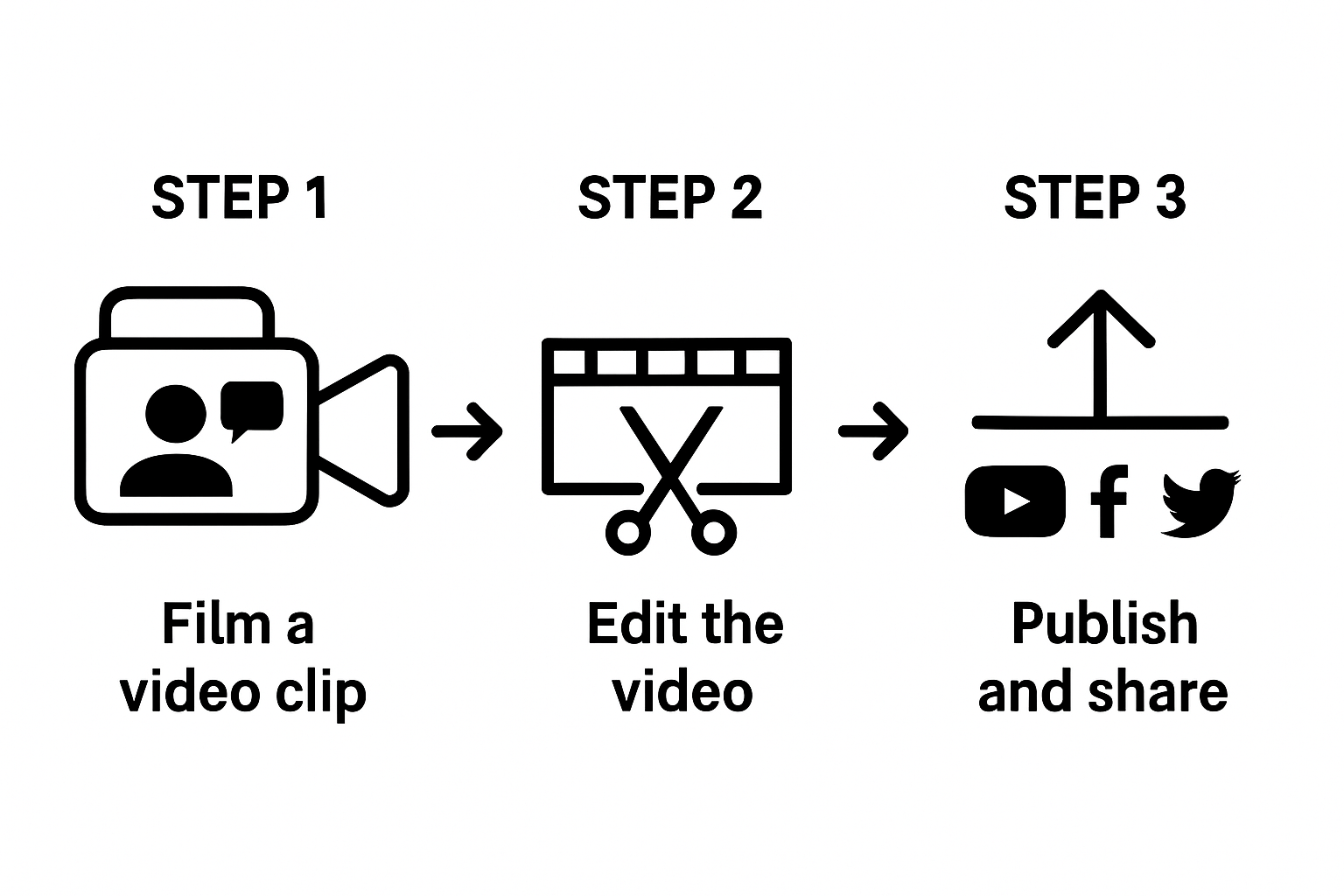Video marketing has exploded, with more than 80 percent of all internet traffic now coming from video content. Most owners rush to film videos hoping for instant results. That approach usually flops because the secret to success is not the camera or editing software. It starts with nailing your business goals before you even hit record.
Table of Contents
- Step 1: Define Your Video Marketing Goals
- Step 2: Identify Your Target Audience
- Step 3: Plan Your Video Content Strategy
- Step 4: Create Compelling Video Content
- Step 5: Distribute Your Videos Effectively
- Step 6: Measure And Optimize Video Performance
Quick Summary
| Key Point | Explanation |
|---|---|
| 1. Define SMART Video Goals | Set specific, measurable, achievable, relevant, and time-bound objectives for your video marketing efforts. |
| 2. Understand Your Target Audience | Create detailed audience personas that capture the interests, needs, and behaviors of your ideal viewers. |
| 3. Develop a Strategic Video Plan | Map out different video types and create a content calendar to ensure consistent and purposeful video production. |
| 4. Create Engaging Content | Focus on storytelling and authenticity, ensuring videos connect with viewers and encourage action. |
| 5. Analyze and Optimize Performance | Use KPIs and regular reviews to measure video success and refine strategies based on audience response. |
Step 1: Define Your Video Marketing Goals
Successful video marketing begins with crystal clear objectives that align with your broader business strategy. Without well-defined goals, your video content will lack direction and fail to deliver meaningful results. The process of defining your video marketing goals requires strategic thinking and a deep understanding of what you want to achieve.
Start by examining your overall business objectives and identifying precisely how video content can support these aims. Are you looking to increase brand awareness, generate more leads, educate potential customers, or drive direct sales? Each goal demands a different video approach and measurement strategy. For instance, brand awareness videos might focus on storytelling and emotional connection, while sales-driven content will prioritize product demonstrations and clear calls to action.
Learn more about developing a comprehensive marketing strategy that integrates video marketing effectively. Your goals should be specific, measurable, achievable, relevant, and time-bound (SMART). A vague objective like “get more views” won’t cut it. Instead, aim for precise targets such as “increase website conversion rates by 15% within six months using explainer videos” or “generate 50 qualified leads per month through targeted video content”.
Consider your target audience carefully when defining these goals. Understanding their preferences, pain points, and content consumption habits will help you craft video marketing objectives that genuinely resonate. Different audiences might prefer short-form social media clips, in-depth tutorials, or customer testimonial videos. By aligning your goals with audience expectations, you significantly improve your chances of video marketing success.
Once you have defined your goals, document them clearly and ensure they are visible to your entire marketing team. This shared understanding will help everyone work towards the same objectives, creating a unified and focused video marketing approach that drives real business results.
Step 2: Identify Your Target Audience
Successful video marketing hinges on understanding exactly who will watch and engage with your content. Identifying your target audience is more than a demographic exercise it is about creating a comprehensive profile that reveals your potential customers’ deepest needs, preferences, and behaviors.
Begin by examining your existing customer base and conducting thorough market research. Look beyond basic demographics like age and location. Dive deeper into psychographic information such as interests, challenges, purchasing behaviors, and online consumption habits. Create detailed audience personas that represent your ideal viewers. These personas should feel like real people complete with names, professional backgrounds, personal motivations, and specific pain points your video content can address.
Learn more about online advertising strategies that can help refine your audience targeting. Analytics tools like Google Analytics, social media insights, and customer surveys can provide rich data about your audience. Pay attention to which content already resonates with your current customers. Analyze metrics such as engagement rates, watch time, and conversion data to understand what truly captures their attention.
Your target audience identification should also consider the specific platforms where your potential customers spend their time. Different demographic groups consume video content differently younger audiences might prefer short-form content on TikTok or Instagram, while professionals might engage more with LinkedIn or YouTube tutorials. Understanding these platform nuances allows you to tailor your video marketing approach precisely.
Remember that audience identification is an ongoing process. Markets evolve, consumer preferences shift, and new trends emerge. Regularly revisit and update your audience personas. The most effective video marketing strategies remain flexible and responsive to changing audience dynamics. By developing a nuanced, data-driven understanding of your target viewers, you create the foundation for video content that truly connects and converts.
Step 3: Plan Your Video Content Strategy
A well-crafted video content strategy transforms random video production into a powerful marketing tool that systematically drives business growth. Your strategy must be more than a collection of random video ideas it needs to be a deliberate roadmap that connects each piece of content to your broader marketing objectives.
Begin by mapping out the different types of videos that will serve your marketing goals. Consider creating a balanced content mix that includes explainer videos, customer testimonials, product demonstrations, behind-the-scenes glimpses, and educational tutorials. Each video type serves a unique purpose in your marketing funnel. Explainer videos might attract top-of-funnel prospects, while detailed product demonstrations could help convert bottom-of-funnel leads.
Here is a quick comparison of the most common video types used in a small business marketing strategy, along with their main purpose and suitable target audience.
| Video Type | Main Purpose | Best For (Target Audience) |
|---|---|---|
| Explainer Video | Clarifying products/services | New or potential customers |
| Customer Testimonial | Building trust/credibility | Prospects needing social proof |
| Product Demonstration | Driving sales/conversions | Bottom-of-funnel leads |
| Educational Tutorial | Providing value/engagement | Curious or DIY-oriented viewers |
| Behind-the-Scenes | Humanising brand/connection | Loyal fans, frequent social followers |
| Short-form Social Clip | Quick awareness/engagement | Younger audiences, fast-scrollers |
| Company Story/Branding | Building emotional connection | All audience segments |
Explore our guide to digital marketing for small businesses to understand how video content fits into your broader strategy. Develop a content calendar that outlines your video production schedule, ensuring consistent and strategic content release. This calendar should align with key business events, product launches, seasonal trends, and audience engagement patterns. Plan your video topics by considering your audience personas and their specific challenges, interests, and information needs.
Quality matters significantly more than quantity in video marketing. Focus on creating fewer, more impactful videos rather than churning out numerous low-quality productions. Each video should have a clear purpose, a compelling narrative, and a strong call to action. Consider your available resources technical skills, budget, and production capabilities when planning your video content. If professional video production is beyond your current means, start with smartphone-recorded content that is authentic and valuable.
Regularly review and adjust your video content strategy based on performance metrics. Track engagement rates, view duration, conversion rates, and audience feedback. Be prepared to pivot your approach if certain video types or topics are not resonating with your target audience.
 The most successful video marketing strategies remain flexible, data-driven, and closely aligned with evolving business goals and customer preferences.
The most successful video marketing strategies remain flexible, data-driven, and closely aligned with evolving business goals and customer preferences.
Step 4: Create Compelling Video Content
Creating compelling video content is an art form that combines technical skill, storytelling prowess, and strategic thinking. Your videos must do more than simply exist they need to capture attention, evoke emotion, and drive meaningful action from your target audience.
Storytelling is the heart of great video content. Begin by developing a narrative that speaks directly to your audience’s experiences, challenges, and aspirations. Your video should feel like a conversation, not a sales pitch. Use a clear structure that includes a relatable problem, an engaging journey, and a resolution that showcases how your product or service provides value. Consider using real customer stories or scenarios that your target audience will immediately recognize and connect with.
Discover more about digital marketing strategies to enhance your content creation approach. Technical quality matters significantly. While you do not need Hollywood-level production, ensure your videos have clear audio, good lighting, and steady framing. Smartphone cameras can produce excellent results when used thoughtfully. Invest in a basic microphone, use natural light or affordable ring lights, and learn basic editing techniques. Free or low-cost tools like DaVinci Resolve, iMovie, or Adobe Premiere Rush can help you create professional-looking videos without extensive technical expertise.
Authenticity trumps perfection in modern video marketing. Viewers appreciate genuine, unpolished content that feels real and immediate. Do not be afraid to show your human side mistakes, behind-the-scenes moments, and candid interactions can create powerful connections. Focus on delivering clear, valuable information that solves a problem or answers a question for your audience. Keep your videos concise most effective marketing videos range between 60 to 90 seconds, maintaining viewer engagement without overwhelming them.
Finally, always include a clear call to action. Whether you want viewers to visit a website, sign up for a newsletter, or contact your business, make this next step explicit and easy to follow. Review your videos critically ask yourself if they would genuinely capture your attention and motivate you to take the desired action. Continuous refinement and a willingness to experiment are key to developing video content that truly resonates with your audience.
This checklist will help you verify that you are covering all critical elements for effective video content creation, as suggested throughout the article.
| Step | Key Action | Complete? |
|---|---|---|
| Set SMART objectives | Define specific, measurable business goals | |
| Create audience personas | Build detailed profiles of target viewers | |
| Develop content calendar | Plan consistent video publishing schedule | |
| Ensure quality production | Use clear audio, good lighting, steady camera work | |
| Tell an authentic story | Include real-world scenarios and genuine voice | |
| Add a strong call to action | Direct viewers to next step (site, signup, contact) | |
| Review and optimise | Regularly check KPIs and refine based on feedback |
Step 5: Distribute Your Videos Effectively
Distributing your video content is not just about posting it everywhere but strategically placing it where your target audience is most likely to engage. A thoughtful distribution strategy amplifies your video’s reach and impact, transforming passive content into an active marketing tool.
Diversify your distribution channels to maximize visibility. Your video marketing strategy should include multiple platforms tailored to different audience segments. Social media platforms offer unique opportunities YouTube works brilliantly for longer educational content, Instagram and TikTok excel with short-form videos, while LinkedIn is perfect for professional and B2B content. Do not limit yourself to a single platform. Repurpose your videos across different channels, adapting the format and messaging to suit each platform’s specific audience and algorithmic preferences.
Explore our guide to online advertising strategies to enhance your distribution approach. Embedding videos on your website is crucial. Create dedicated landing pages that showcase your video content, ensuring they are optimized for search engines. Consider using video thumbnails that are visually compelling and include clear, intriguing titles that encourage clicks. Email marketing remains a powerful distribution channel integrate your videos into newsletters, providing subscribers with valuable, engaging content that drives them back to your website or social media channels.
Understand the power of paid distribution and targeted advertising. Platforms like Facebook, Instagram, and YouTube offer sophisticated targeting options that allow you to reach specific demographics, interests, and behaviors. Allocate a portion of your marketing budget to promote your best-performing videos, extending their reach beyond organic distribution. Track performance metrics carefully views, engagement rates, click-throughs, and conversion rates will help you refine your distribution strategy continuously.
Remember that distribution is an ongoing process. Monitor your video performance across different platforms, be willing to experiment with new channels, and stay adaptable. The digital landscape evolves rapidly, and your distribution strategy should be flexible enough to capitalize on emerging platforms and changing audience preferences. Consistent, strategic distribution turns your video content from a one-time production into a dynamic, ongoing conversation with your target audience.
Step 6: Measure and Optimize Video Performance
Measuring and optimizing video performance transforms your marketing from guesswork into a precise, data-driven strategy. Without comprehensive analytics, your video marketing efforts are like navigating without a compass blindly hoping to reach your destination.
Key performance indicators (KPIs) are your navigational tools. Focus on metrics that directly connect to your initial marketing goals. View count is just the surface level dig deeper into engagement rates, watch time, click-through rates, and conversion metrics. Platform-specific analytics from YouTube, Facebook, and Instagram provide granular insights into how viewers interact with your content. Pay special attention to moments where viewers drop off this reveals exactly where your video might be losing audience interest.
Learn more about marketing analytics for small businesses to refine your measurement approach. Implement advanced tracking by using unique UTM parameters for each video distribution channel. This allows you to understand not just overall performance, but precisely how each platform and specific video variation contributes to your marketing objectives. Google Analytics and platform-specific tracking tools can help you create a comprehensive performance dashboard.
Optimization is an ongoing process of incremental improvements. Conduct regular A/B testing with different video elements thumbnail designs, titles, content lengths, and calls to action. Small tweaks can produce significant performance shifts. Create a systematic review process where you analyze video performance monthly, identifying patterns and trends. Look for commonalities in your most successful videos what topics, styles, or approaches consistently generate the best results?
Remember that optimization extends beyond the video itself. Examine your entire distribution strategy. Some videos might perform exceptionally well on one platform but poorly on another. This does not mean the video is bad it means your distribution strategy needs refinement. Be prepared to pivot quickly, reallocate resources to high-performing channels, and continuously experiment. The most successful video marketers treat their content as a living, evolving strategy that adapts based on real-world performance data.

Turn Your Video Marketing Vision into Real Business Growth
Are you struggling to move from nice-looking videos to real results for your business? If defining a clear strategy, targeting the right audience, or measuring success feels overwhelming, you are not alone. Many businesses invest time and effort in video content but never see the sales or leads they hope for because their marketing efforts lack technical precision and a data-driven plan.

Now is the time to get expert support to unlock your video marketing’s full potential. With Zoo Digital, you gain access to specialists in tracking setup, digital ads, automation, and analytics – all essentials mentioned throughout this article. Get your hands on actionable reporting, campaign optimisation, and transparent ROI. Visit our main site to learn more or explore our full range of solutions tailored for your business growth. Ready to turn every video into a money-making machine? Book a discovery call with Zoo Digital today and let’s get your business noticed.
Frequently Asked Questions
What are the key goals for video marketing?
Successful video marketing goals may include increasing brand awareness, generating leads, educating customers, or driving sales. Each goal requires a tailored video approach and measurable strategies.
How can I identify my target audience for video marketing?
To identify your target audience, analyze your existing customers, delve into their demographics, psychographics, and behaviors. Create audience personas to represent ideal viewers, and consider their preferred content platforms.
What types of videos should I include in my marketing strategy?
A well-rounded video marketing strategy should incorporate various types of videos such as explainer videos, customer testimonials, product demonstrations, and educational tutorials. Each type serves a distinct purpose in engaging different stages of your marketing funnel.
How do I measure the performance of my video content?
Key performance indicators (KPIs) for video measurement include engagement rates, watch time, click-through rates, and conversion metrics. Use analytics tools for detailed insights and conduct regular A/B tests to optimize your video strategy.
Recommended
- How to Build a Marketing Strategy for Small Businesses in 2025 – Zoo Digital
- Digital Marketing for Beginners: 2025 Guide for Small Businesses – Zoo Digital
- How to Start Online Advertising: Guide for Small Businesses 2025 – Zoo Digital
- Digital Marketing Terms Explained for Small Businesses 2025 – Zoo Digital

